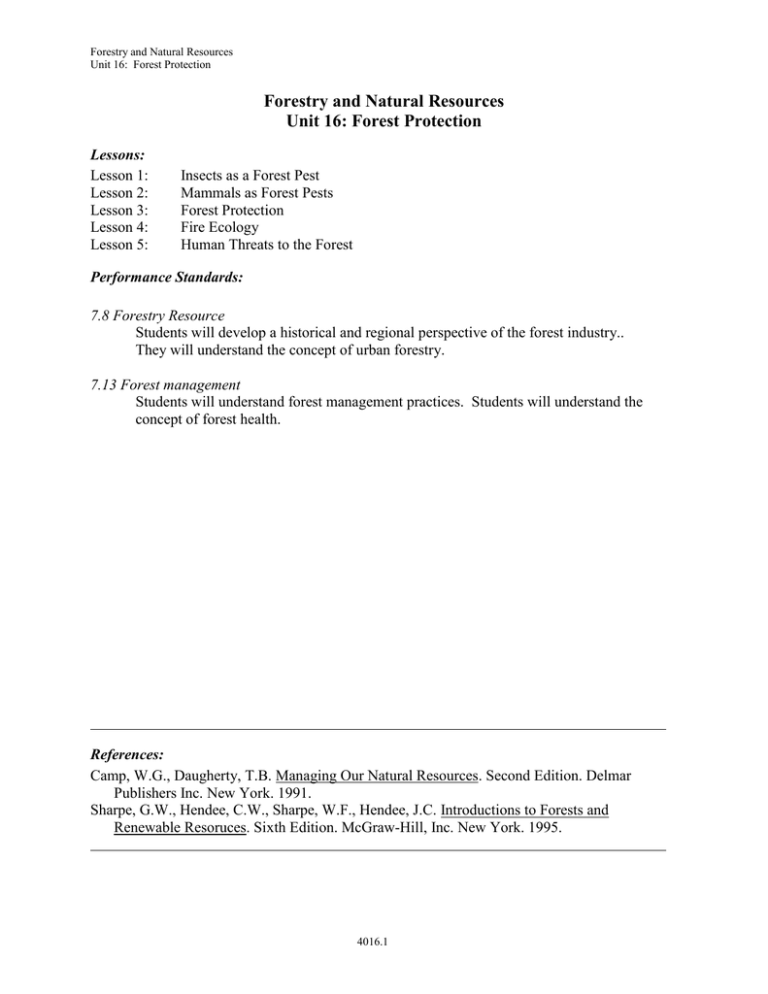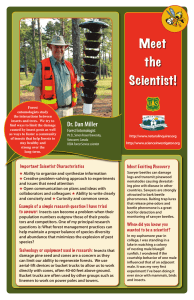Lesson 1 Insects as a Forest Pest
advertisement

Forestry and Natural Resources Unit 16: Forest Protection Forestry and Natural Resources Unit 16: Forest Protection Lessons: Lesson 1: Lesson 2: Lesson 3: Lesson 4: Lesson 5: Insects as a Forest Pest Mammals as Forest Pests Forest Protection Fire Ecology Human Threats to the Forest Performance Standards: 7.8 Forestry Resource Students will develop a historical and regional perspective of the forest industry.. They will understand the concept of urban forestry. 7.13 Forest management Students will understand forest management practices. Students will understand the concept of forest health. References: Camp, W.G., Daugherty, T.B. Managing Our Natural Resources. Second Edition. Delmar Publishers Inc. New York. 1991. Sharpe, G.W., Hendee, C.W., Sharpe, W.F., Hendee, J.C. Introductions to Forests and Renewable Resoruces. Sixth Edition. McGraw-Hill, Inc. New York. 1995. 4016.1 Forestry and Natural Resources Unit 16: Forest Protection Unit 16: Forest Protection Lesson 1: Insects as a Forest Pest Duration: 3 Hours Students will be able to: 1. Identify the major insect types (defoliators, bark beetles, etc.) present in North American forests. 2. Explain the various strategies used to control forest pests. Suggested Activities: 16.1A Harmful Insects - Using slides, show the students the different insects that harm timber in California. 16.1B Guest Speaker - Have a local forester speak to the class -- ask that person to bring with them samples of wood destroyed/damaged by insects. 16.1C Debate - Debate the different control methods -- focus on the controversy over chemical controls and the opportunities that integrated pest management may (or may not) provide. 16.1D Destructive Pests - Each student researches an assigned pest and develops a collection of the most destructive pests in California. This collection should contain information concerning each pest's life cycle, management methods, economic significance, and symptoms recognition. Teaching Outline I. Forest pests: insects A. Insects constitute 90% of the species found in the animal kingdom. 1. There are many beneficial insects. 2. Harmful insects, however, destroy more timber in the U.S. than any other factor a. They also cause limb and leaf dieback (without killing the tree) and stunt growth. 3. Insects are difficult to deal with because of their size, reproductive ability and mobility. 4. Natural controls (Including food, competition, predation, parasites, excessive heat, and cold or moisture) usually work to keep insect populations in check. B. Sucking insects 1. Attack both foliage and stems. 2. Sucking mouth parts pierce tissues and suck fluid from trees. 3. Most prevalent species include aphids, scale insects, tree bugs and cicadas. 4. Damage to forest trees from sucking insects is usually minor, requiring few, if any, controls. C. Defoliators 1. Attack needles and leaves of trees. 2. Chewing mouth parts defoliate leaves; these insects often attack trees in a stand. 3. Deciduous trees can usually withstand 3 consecutive years of attack without serious harm. 4. Evergreen trees will often die after one complete defoliation. 4016.2 Forestry and Natural Resources Unit 16: Forest Protection 5. Harmful defoliators include spruce and western spruce budworm, Douglas fir tussock moth, pine butterfly, hemlock looper, gypsy moth, tent caterpillars, and sawflies. 6. Controls include large scale (aerial) application of insecticides, as well as biological control. D. Bark beetles 1. Considered to be more destructive than defoliators, bark beetles pose a serious threat to timber trees. 2. Although life histories vary, most follow the below pattern: a. The first attacking insect enters a tree and severs the resin ducts. b. If the tree cannot resist the attack, the invading insect sends out a chemical message (pheromone) to attract neighboring bark beetles. c. Thousands of bark beetles attach the tree; a tree will try to “pitch out” the insects by releasing resin, but the mass attack usually overwhelms the tree. d. Females lay eggs in the galleries that have been dug into the inner bark (the phloem). e. Once the eggs hatch, the larvae “mines” its way out, girdling the tree and killing it from within. f. Generally, the insects spend the winter in one host and start the process over in the spring. 3. The most destructive bark beetles are the southern pine beetle, turpentine beetle, western pine beetle, mountain pine beetle, Douglas fir pine beetle, spruce beetle, pine engraver beetle, and fir engraver beetle. 4. Traditional methods of control include felling, burning, spraying, selective thinning, and other chemical controls, including synthetic pheromones to attract beetles away from prime timber lots. E. Other destructive insects 1. Wood borers: damage usually comes after the tree has been felled, but before it has been harvested; insects usually use abandoned tunnels; species include ambrosia beetles, woodwasp larvae, carpenter ants, and termites. 2. Terminal feeders: usually damage seedlings (very serious in nurseries and plantations); species include twig beetles, weevils, and midges. 3. Root feeders: attack young trees; species include white grubs, some weevils, termites, and wireworms. 4. Gall makers: after an insects larvae is deposited on a limb, a gall forms to provide protection and food for the growing insects; it is usually not harmful to trees; examples of galls include the oak wasp gall, aphid gall, Cooley spruce gall, and midge gall. 5. Cone and seed insects: destroy trees before they germinate; lay eggs on the outside of the seed and developing larvae bore their way in for food. 4016.3 Forestry and Natural Resources Unit 16: Forest Protection F. Controlling forest pests 1. Silvicultural controls a. This method creates unfavorable conditions for potential pests. b. Must know the natural history of the invader (does the insect have any key predators, does the insect tolerate extreme temperatures, what are the spoil needs. c. Sanitation cutting can remove damaged or susceptible trees from a stand. d. An even-aged stand is more susceptible to attack than one with multiple ages. e. Often selecting the “right tree for the right place” is the key to controlling insect infestations -- know what insects are present and avoid planting host trees or plant for resistant stock. f. Typical control practices include burning slash and affected trees, submerging logs in mill lakes, and providing sprinkler systems to spray the top of log decks 2. Biological controls a. This method works by either introducing known predators or through disturbing growth and/or reproductive cycles. b. Fungi, bacteria, viruses, parasites, and predators (other insects, small mammals, reptiles, birds, etc.) are all biological control agents. c. Exotic insects are often introduced from abroad and since they usually no not have any natural predators in their new “home”, they spread rapidly; introduction of natural predators from their native habitat may be the only way to control the invading insects. 3. Chemical controls a. Using chemical controls (pesticides and herbicides) is the most common, most dangerous (to both humans and the environment), most expensive, and most controversial way to control insects. b. An effort has been made to develop organic pesticides that act as either direct contact or stomach poisons. c. Synthetic pheromones have been used to lure populations of insects away from high quality lumber and to trap males to interrupt the mating cycles. d. Chemical controls should be used as an emergency treatment to control epidemic outbreaks. 4. Integrated pest management (IPM) a. IPM shifts the perception from chemical control to an integrated management scheme; focuses on keeping populations in check, and not complete eradication. b. This method recognizes that insects are a natural and necessary part of the ecosystem. c. IPM often uses a combination of controls (silvicultural, biological, and chemical) to manage outbreaks. 4016.4 Forestry and Natural Resources Unit 16: Forest Protection Forest Insects California Pine Engraver Genus: Ips Western Pine Beetle Dendroctonus brevicomis Dendroctonus larvae Galleries Flathead Borer Genus: Melanophila Flathead Fir Borer larvae Melanophila drummondi 4016.5 Cedar Borer Genus: Trachykele Fir Engraver Genus: Scolytus Forestry and Natural Resources Unit 16: Forest Protection 4016.6 Forestry and Natural Resources Unit 16: Forest Protection 4016.7



